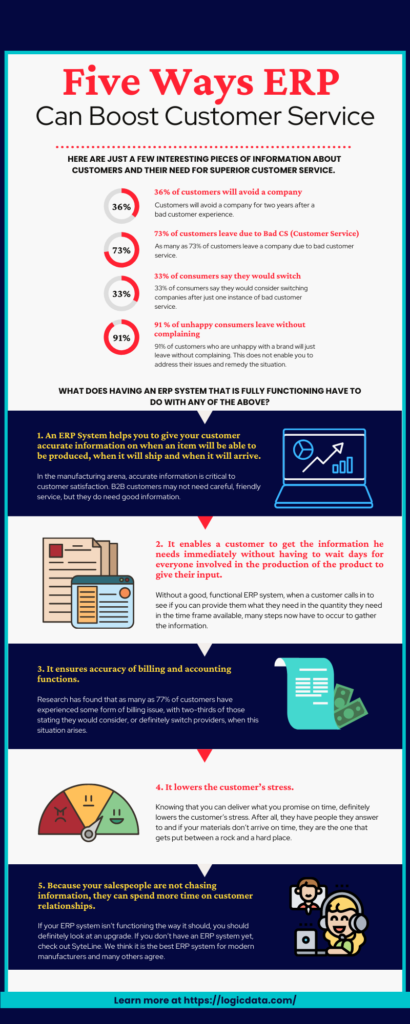

There are few things more irritating than calling up a store to ensure they have what you need, being told that they do in fact have the item, then getting in your car and driving to the store only to find that the computer was wrong, and they in fact do not have any of what you want. At that point, no amount of friendly interaction or attempted help from the store salespeople is going to make you happy with that company.
On the manufacturing side of things, similar scenarios occur. Your customers want to know if you have the item in stock. If not, they want to know when you will be able to produce it and in what quantity. They also need to know how fast you can ship it. If you tell them the answers to these questions and the answers do not turn out to be true, you can lose all future sales from that customer. If you supply parts that customer needs to make their product, the problems increase exponentially. Missing parts can make the customer’s life miserable, thus ensuring that they won’t be doing business with you anymore.
These figures impact a retail operation somewhat, but in a manufacturing setting, losing even one major customer can seriously impact your bottom line.
In the manufacturing arena, accurate information is critical to customer satisfaction. B2B customers may not need careful, friendly service, but they do need good information. That isn’t to say that you should be gruff with them, it is just that their satisfaction has to do with whether or not you can give them what they need when you say you will. A good ERP system can ensure that this can be provided.
Without a good, functional ERP system, when a customer calls in to see if you can provide them what they need in the quantity they need in the time frame available, many steps now have to occur to gather the information. You have to check with the inventory department to see how many of the item are currently in stock. Then you have to check with the sales department to see how many of those items in stock have been promised to another customer. You have to then check with the production department to see what is in line to be produced when, to see when your order could be produced. And finally, you should probably check in with accounts to ensure this customer is not in arrears. All this could take days.
We live in a society where instant gratification isn’t just a nice thing, it is expected. We log onto Amazon and find out instantly how soon we can get what we want. Then with a click of a button, we order it, and it is on its way.
If a customer has to wait several days to find out if you can supply their need, they will probably look for a company that can answer their question today. You will then become a last resort. If another company can provide them the information about the product before you can, the other company will usually get the sale.
Most people get quite upset when a company can’t keep their accounts straight. Inaccurate billing is a major problem and can lead to very disgruntled customers. Research has found that as many as 77% of customers have experienced some form of billing issue. Two-thirds of those state that they would consider, or definitely switch providers, when this situation arises.
Knowing that you can deliver what you promise on time, definitely lowers the customer’s stress. After all, they have people they answer to and if your materials don’t arrive on time, they are the one that gets put between a rock and a hard place. Knowing they have a supplier they can trust can lower the customer’s stress level and increase his satisfaction and loyalty.
If your salespeople are chasing information, they can’t really spend the much of their time nurturing their current customer base. When you free up that time, they can utilize their skills to increase customer loyalty, find out if the customer needs something they haven’t mentioned and just generally improve the relationship between your company and theirs. This is a very valuable but often overlooked portion of customer service. and can definitely increase customer satisfaction with your brand.
So, if your ERP system isn’t functioning the way it should, you should definitely look at an upgrade. If you don’t have an ERP system yet, check out SyteLine. We think it is the best ERP system for modern manufacturers and many others agree.
Contact us for more information.

As with cost, implementation time is also dependent on the same factors mentioned above. LogicData offers multiple implementation methodologies that can be adapted to your specific needs and resource availability. Considering a very basic implementation of just the core functionality of SyteLine, and employing a LogicData managed implementation approach, time to value can be achieved in as little as 3-4 months. A full implementation of all core SyteLine functionality utilizing a standard implementation approach, and assuming full client resource availability, can generally be completed in 6 to 8 months. To determine the best implementation methodology and timeline estimate for your specific situation, please contact us.
The cost of software and implementation will vary based on many factors such as user count, functionality requirements, deployment, implementation methodology, customization, data conversion, integration, and internal resources. However, for a basic configuration of SyteLine annual subscription pricing can begin at approximately $18,000 annually for a minimum of 10 users or a one-time cost of $20,000 plus annual maintenance for a minimum of 5 users in an on-premise deployment. A primarily self-directed implementation of such a basic configuration, although not recommended, can likely be achieved for approximately $30,000. LogicData recommends our standard “train-the-trainer” implementation approach which is estimated to start at roughly $65,000 for a basic implementation. For further information on pricing specific to your needs, please contact us.
Leave a Reply